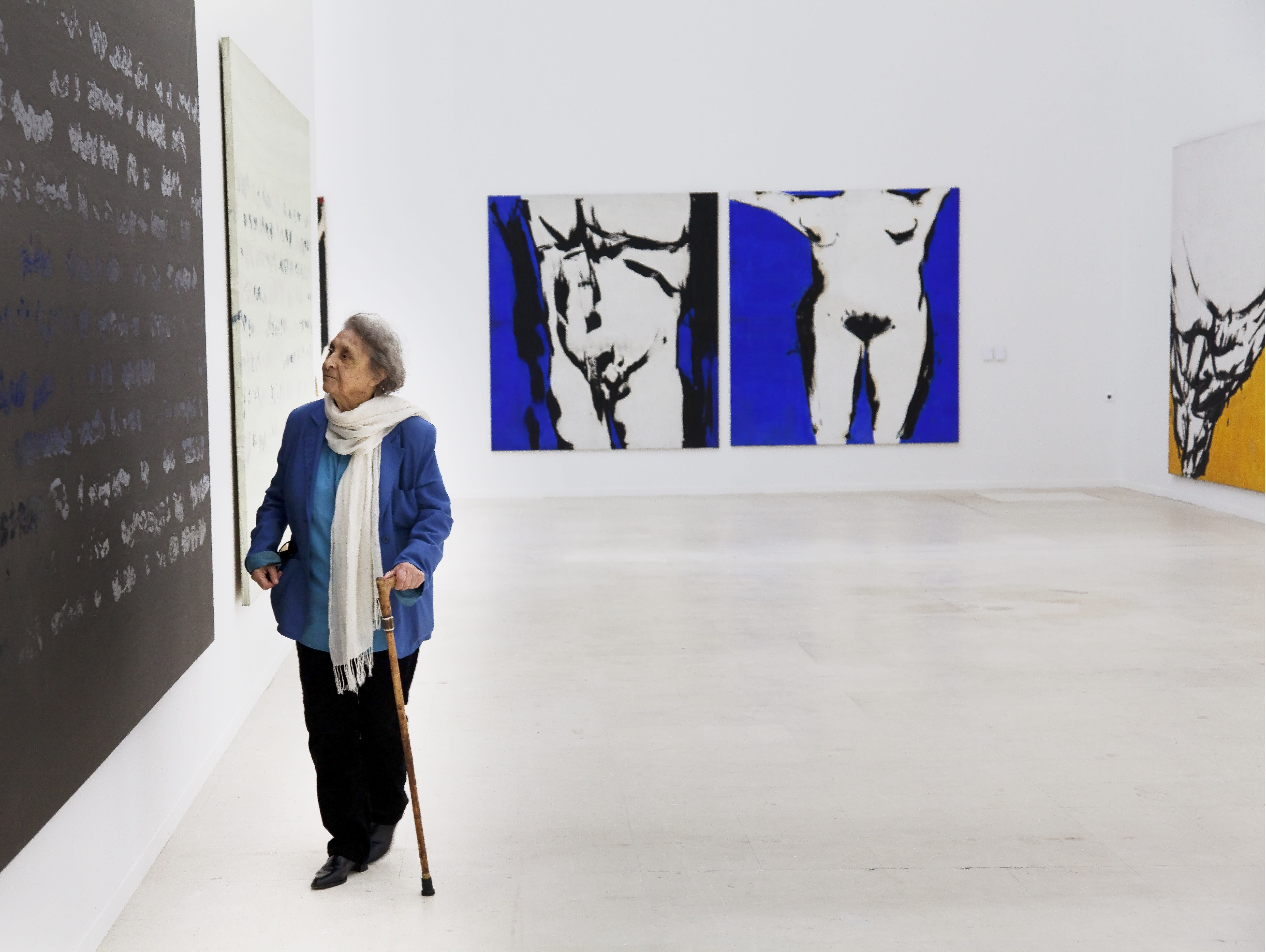 |
 |
© Photos Philippe Boudreaux
Judit Reigl’s work is both entirely of its time and extremely singular.
Born in Kapuvar in Hungary in 1923, Judit Reigl went to Budapest in 1941 and enrolled in the Fine Arts School there. ‘I borrowed from all the other students who interested me. I was on the ball, but I was always honest,’ she said in an interview. After the interruption of the war, she began studying again in 1945, and travelled to Italy in 1946 with a bursary from the Hungarian Academy in Rome. She will be deeply marked by the site-specific
works of the Renaissance and Baroque masters she discovered there. In Ravenna, Reigl met the English poet and sculptor Betty Anderson (1911-2007), who became her life partner.
When she returned to Hungary in 1948, Reigl found the country in the grip of an authoritarian Communist regime. She decided to flee, and finally passed through the Iron Curtain on the 10th of March 1950, after eight failed attempts. It took her three atrocious months to reach Paris, where she was taken in by the expat Hungarian community (Simon Hantaï, his wife, and Antal Biro) and moved into a studio in La Ruche.
‘My whole body of work is a single series, from age three to the present. [...] The truth is that for my entire life, I have never done anything other than paint, or try to paint as soon as I had the chance.’
In 1954, André Breton discovered Reigl’s painting Ils ont soif insatiable de l’infini. He wrote to her: ‘I believe you have it in you to make immense accomplishments’and offered to show her work at the gallery À l’Étoile scellée. This will be a decisive encounter for Reigl. While she never belonged to the Surrealist group, she shared some of their concerns and had a ‘both psychically and physically total’ automatic practice. Throughout her career, she was accompanied by literature, and above all poetry and music. Reigl worked in series, abandoning paint brushes from 1951 onwards and making her own tools, like the curtain rod she used to ‘write’ her paintings.
Éclatement, Centre de dominance, Guano, Écriture en masse, Expérience d’apesanteur, Homme, Drap, décodage, Déroulement, Art de la fugue, Volutes, Un corps au pluriel, Entrée-Sortie, Un corps sans prix are the titles of the series that come one after another, sometimes overlapping each other, between 1956 and 2008. If a figure emerged unexpectedly, Reigl accepted it and began a new series, moving from abstraction to anthropomorphic figuration, then back again. This is what the art world finds so troubling about Reigl’s body of work, which they are unable to classify, forcing them instead to follow the powerful, energetic flows of her process: ‘My whole body is involved in my work, my arms spread wide open. It’s with gestures that I write in the space given through rhythm, through beats, beats’.
‘The series Dominance (1958-59) is motivated by a centrifugal force, and Écriture en masse (1959-65) by a centripetal force. The series follow one another like waves, as if I was breathing out, then breathing in [...] The series Écriture en masse (1959-65) is perhaps a recollection of the first time I saw the sun rise up from the mass of the sea with three huge purple rocks in the foreground.’
In 1966, while Reigl was working on a piece in the series Écriture en masse, a monumental torso emerged, asserting itself and opening up a new series, Homme, which surprised both critics and professionals. She painted more than a hundred of these anthropomorphic figures, at times dramatically coloured, which were only rarely exhibited. With the series Déroulement (1973-85), linked to Mozart, and Art de la fugue (1980-82), linked to Bach, Reigl lead her viewer on a stroll through colour and music. She made these paintings as she walked back and forth listening to her favourite music, the canvases hanging on the wall, using a stick wrapped in fiberglass dipped in paint. Marcelin Pleynet emphasises the aesthetic beauty of these works that would soon find an international audience.
Beginning in 1988, the human figure returned to Reigl’s work, their forms walking or floating through the spaces of Face à... and Corps au pluriel. Their identity is often neutral and apparently in suspense, outside of the violence of the world: ‘The body: the most perfect instrument and the most tragic obstacle. For more than 15 billion years. Agglomeration, fusion, separation, attraction, repulsion, growth, reduction, transformation, mutation, explosion, implosion, dissolution. Desire, suffering, death, rebeginning.’
Following an exhibition of her work at Galerie Drouin in 1956 alongside Georges Mathieu, Simon Hantaï, and Jean Degottex, Reigl was represented by Jean Fournier at Galerie Kléber from 1956 to 1962. From 1972 to 1976, she exhibited at her partner Betty Anderson’s Galerie Rencontres. After that, she was at Galerie Yvon Lambert until 1982, then Catherine Thieck’s Galerie de France.
Following her death on August 6th, 2020, the Fonds de dotation Judit Reigl became responsible for her catalogue raisonné together with the promotion of her work, which is now represented by kamel mennour.
— Blandine Chavanne